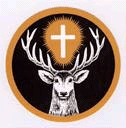
Eustace Families Association

CASTLES MAKE STEPPINGSTONES TO IRELAND
Donald W. Eustace
As the study of history in Norman England continues, thepossibility of finding a connection between Irish and EnglishEustace families recedes. The families brought together by themarriages of Eustace FitzJohn appear to be Norman with no contactwith the Boulognais, apart from the alliance for the conquest in1066. The Norman’s main holdings of land were in the northwhile the Boulogne influence in East Anglia did not extend northof Lincoln.
Ivo de Vesci, descended from the family at Vassy in the Conderegion of Normandy, was given Alnwick when its previous owner,Gilbert de Tesson was involved in rebellion. It was inherited byhis daughter, Beatrice.who married Eustace FitzJohn, to whom itpassed. It was during his regime that most of the present castlewas built. Beatrice died in childbirth and Eustace made a secondsuccessful marriage with Agnes (also called Maude), heiress ofWilliam FitzNeel (also called FitzNeal and FitzNigel) lord ofHalton and hereditary constable of Chester Castle. This and theother castles named were largely build during this era.
The sons of the first marriage took their mother's name of deVesci from whom they inherited Alnwick and its lands. The son ofthe second marriage to Agnes, known as both Robert and Richard,inherited Halton and constableship of Chester. He married Alfredaof Lisours, the niece of Ilbert de Laci, heiress of hergrandfather of Pontefract. Her grandson. Roger changed his nameto de Laci. It was his younger brother, John, who retained theFitzEustace name which he took to Ireland with Hugh de Laci in1180.
William FitzNeel, the father-in-law of Eustace FitzJohn,established a priory at Runcorn which he later moved to Norton.He died before the priory church was completed and this was doneby Eustace FitzJohn. One of his sons, Galfrid, later becameprior. (Ruins of the priory can still be seen near Halton). Hegave tithe and benefice rights of a number of manors scattered inEngland including Pyrton in Oxfordshire to Norton Priory whonominated the vicar for several centuries. It is the same villagewhere the Eustace Families Association was established at thefirst Muster of the family in 1979. It had been chosen as a venuebecause of the16th century association without knowledge ofearlier connection.
There is another tenuous or maybe coincidental connection in amention that William FitzNeel had Flemish family connections withwhom he was in contact. Were they Flemish or Boulonnais ?
The Norman Eustaces in the north of England, with their alliedfamilies were all supporters of the Empress Matilda and her sonHenry Plantagenet, in opposition to King Stephen and Matilda ofBoulogne. Although defeated at the battle of the Standard, thenortherners were allowed to keep their castles. Sixty yearslater, opposition to King John under Eustace de Vesci in thenorth and Eustace Bishop of Ely in East Anglia, led the MagnaCarta in which de Vesci was nominated as a representative of thebarons.
In Ireland Hugh de Laci, John FitzEustace's relative and leader,was made joint ruler of Dublin with de la Poer. De Laci wasassassinated four years later and John FitzEustace joined de laPoer when he took over the whole of Dublin. The familiesintermarried later.
Government of that part of Ireland which the Normans hadconquered, was known as 'the pale’ and followed theirpractice of a series of castle strongpoints for defence andcontrol.
During the following four centuries there were Eustaces appointedgovernors of castles at Ballymore, Carbury, Wickmore, Kilkea,Blackwood, Ballysax and Naas in Ireland.